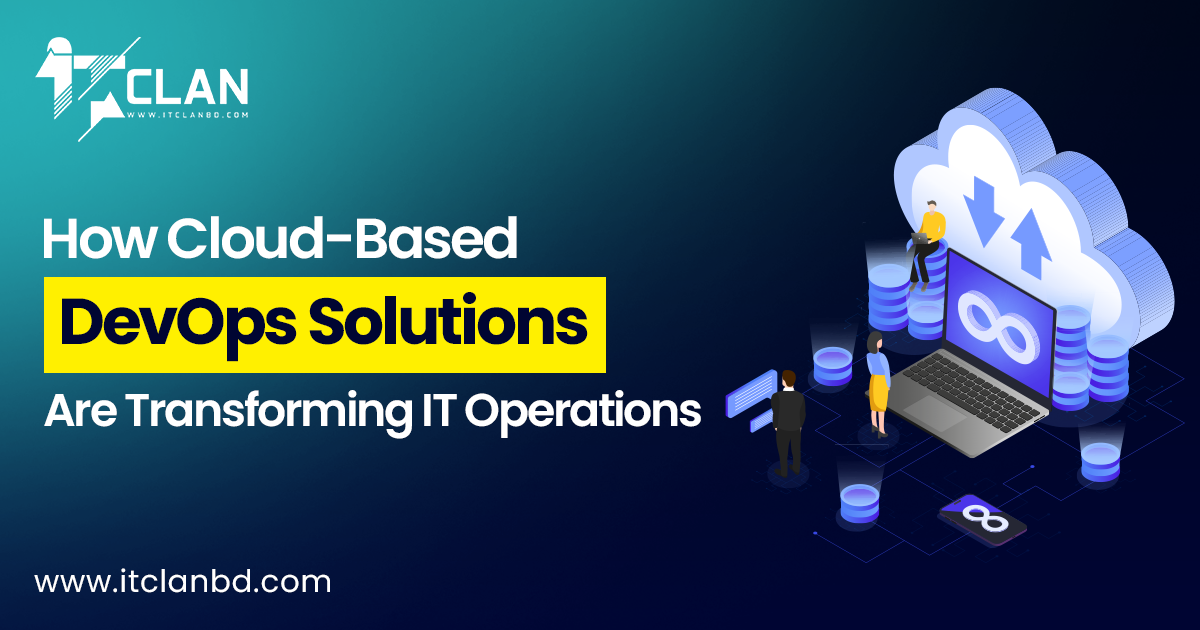
Our Blog Details
Home / Our Blog DetailsLet’s be honest—if you’ve ever worked in software development, you’ve probably seen the awkward dance between the development and operations teams. Developers want to release new features fast, while operations want to make sure nothing crashes. And when something breaks? The finger-pointing begins.
But what if there was a better way to work together? That’s exactly where DevOps steps in. In this blog, we’ll break down what DevOps is, how it bridges the gap between development and operations, and why it’s a total game-changer for modern businesses.
What is DevOps?
Let’s keep it simple. DevOps is a culture, set of practices, and tools that bring development (Dev) and operations (Ops) teams together. The goal? To shorten the development lifecycle, deliver features faster, and improve product quality.
Instead of working in silos, both teams collaborate from the start: planning, building, testing, deploying, and maintaining software together. Think of it like DevOps is the friendly bridge that helps teams work smarter, not harder.
Key Principles of DevOps
- Automation
Automate routine tasks like testing, deployment, and server setup to save time and reduce human errors. - Continuous Integration & Continuous Deployment (CI/CD)
Merge code changes frequently, test automatically, and deploy updates quickly to keep software delivery smooth and fast. - Monitoring & Feedback
Keep an eye on system performance and gather feedback to spot issues early and improve continuously.
Collaboration & Communication
Break down silos—ensure devs, testers, and ops teams work together closely for faster and better results.
What is the Gap Between Development & Operation Teams?
Before DevOps became a thing, development and operations were two separate worlds.
- Developers focused on building new features quickly.
- Operations focused on stability, security, and keeping things running smoothly.
The result? Miscommunication. Developers would toss new code “over the wall,” and operations would struggle to run it. When things broke, the blame game started. No one was truly on the same page.
This gap caused:
- Slow release cycles
- Frequent bugs in production
- High stress during deployments
- Poor customer experience
Clearly, something had to change. And the result is DevOps. It not only collaborates between the two teams but also fuels the smooth process of software development and ensures a better quality of the software product. Without regular maintenance, even the best DevOps practices can’t prevent performance issues — here’s how consistent upkeep helps avoid costly outages.
So, How Does DevOps Bridge the Gap?
Here’s how DevOps creates a smooth, collaborative environment where both dev and ops can thrive:
1. It Builds a Culture of Collaboration
The biggest strength of DevOps? Teamwork.
With DevOps, developers and operations specialists work together from day one. They share goals, tools, and responsibilities. No more “us vs. them.” Everyone is part of one unified team focused on delivering value to customers.
Daily stand-ups, joint planning sessions, and shared dashboards help everyone stay aligned. When everyone understands the bigger picture, it becomes easier to work toward a common goal.
2. It Automates Everything Possible
Let’s face it—manual tasks slow things down and create room for human error.
DevOps relies heavily on automation, especially for:
- Continuous Integration (CI): Automatically building and testing code whenever someone makes a change.
- Continuous Delivery (CD): Automatically pushing code changes to production after they pass tests.
This means faster, safer, and more reliable releases. No more late-night deployments or guessing whether the code will crash the server.
3. It Uses Infrastructure as Code (IaC)
Ever heard of “it works on my machine”? Yeah, DevOps fixes that.
With Infrastructure as Code, developers and operations teams define infrastructure (servers, databases, networks) using code. This code can be versioned, reviewed, and reused—just like app code.
Benefits of IaC:
- Consistent environments across dev, staging, and production
- Faster setup of infrastructure
- Easier rollback if something goes wrong
No more surprises when moving code from one environment to another.
4. It Provides Continuous Monitoring and Feedback
DevOps doesn’t just stop at deployment—it includes real-time monitoring and feedback loops. This helps teams catch bugs before users do and improve performance continuously.
Tools like Prometheus, Grafana, and ELK Stack give deep insights into how apps behave in the real world. If something fails, teams get alerts immediately, fix issues faster, and learn from incidents.
This builds trust between teams and ensures a smoother user experience.
5. It Encourages Using the Right Tools
DevOps isn’t just a process—it’s powered by a modern toolchain that supports collaboration and automation.
Some popular DevOps tools include:
- Jenkins / GitHub Actions – for CI/CD
- Docker / Kubernetes – for containerization and orchestration
- Terraform / Ansible – for IaC
- Slack / Microsoft Teams – for communication
- New Relic / Datadog – for performance monitoring
When teams use the same tools, they speak the same language. This reduces friction and helps things move faster.
How Do DevOps Engineers Work?
Let’s learn how the DevOps engineer works. Then, you can understand the full process of DevOps and realize how the engineer works, how it bridges the gap. DevOps engineers work by combining development, operations, and automation tools to create a smooth, efficient workflow from code creation to deployment. Here’s a simple breakdown of how they work:
1. Automate the Development Process
DevOps engineers set up tools to automate repetitive tasks like:
- Code integration
- Testing
- Building software
- Deploying updates
They use tools like Jenkins, GitLab CI/CD, or GitHub Actions to make sure code changes are tested and deployed automatically.
Want to boost your site’s performance? Check out this WordPress speed optimization guide.
2. Build and Manage CI/CD Pipelines
A CI/CD pipeline is a workflow that automatically builds, tests, and deploys code. DevOps engineers:
- Create pipelines to ensure faster delivery
- Catch bugs early with automated tests
- Deploy updates quickly without downtime
3. Use Containers and Virtualization
DevOps engineers use tools like Docker and Kubernetes to:
- Package applications in containers (portable, lightweight environments)
- Ensure consistency across development, testing, and production environments
- Scale applications easily
4. Manage Infrastructure as Code (IaC)
They use tools like Terraform or Ansible to manage servers and environments using code. This makes infrastructure:
- Easy to replicate
- Version-controlled
- Faster to update
5. Monitor and Secure the System
DevOps engineers monitor performance, uptime, and security using tools like:
- Prometheus, Grafana, or Datadog for monitoring
- ELK Stack for logging
- Security tools to prevent vulnerabilities
6. Collaborate Across Teams
They work closely with:
- Developers to understand code and features
- QA testers to ensure quality
- IT teams to manage deployment and support
They help everyone stay on the same page using collaboration tools like Slack, Jira, or Confluence. In Simple Words, DevOps engineers make the software delivery process faster, smoother, and safer—by using automation, smart tools, and teamwork.
The Real Benefits of DevOps Service
Let’s talk about what DevOps actually delivers when implemented properly:
- Faster Releases: CI/CD pipelines make it easy to ship code daily, not monthly.
- Fewer Bugs in Production: Automated testing and early feedback reduce nasty surprises.
- Better Team Morale: No more late-night panic deployments or blaming each other.
- Higher Customer Satisfaction: Faster updates, better features, and more stable systems mean happier users.
- More Innovation: Less time fixing issues means more time building awesome features.
Whether you’re a startup or a large enterprise, DevOps helps you move with agility while maintaining control.Discover how smart UI/UX design can significantly boost your website’s conversion rates.
Common Challenges (And How to Beat Them)
Sure, DevOps sounds amazing—but adopting it isn’t always smooth sailing. Here are a few challenges you might face (and how to overcome them):
- Resistance to Change: Teams used to working separately may be hesitant. Start with small wins—automate one process or run one joint project to show the benefits.
- Lack of DevOps Skills: Invest in training or bring in experienced consultants to guide your team.
- Too Many Tools, Not Enough Strategy: Don’t adopt every shiny new tool. Focus on building a culture first, and choose tools that align with your team’s needs.
Leadership Buy-in: Make sure leadership understands the value of DevOps. Use metrics (like faster release cycles and fewer outages) to make your case.
Best Practices to Make DevOps Work for You
Want to succeed with DevOps? Keep these tips in mind:
- Start Small, Scale Gradually: Begin with one team or project. Refine your approach and expand.
- Focus on Culture, Not Just Tools: DevOps is about people working better together. Tools support that, but can’t replace it.
- Automate Intelligently: Don’t automate just for the sake of it. Identify the biggest bottlenecks and solve them first.
- Measure Everything: Track key metrics like deployment frequency, lead time, failure rate, and recovery time.
Never Stop Improving: Hold retrospectives, listen to feedback, and keep refining your process.
Final Thoughts
The gap between development and operations teams isn’t just frustrating; it can seriously slow down your business. But DevOps offers a smart, modern way to bridge that gap.
By focusing on collaboration, automation, and continuous feedback, DevOps helps teams deliver faster, work better, and make customers happier. It’s not just a trend, it’s a proven strategy for success. Do you need DevOps help? If yes, then I can suggest you a reliable name: ITclan BD!
Need Help Implementing DevOps?
At ITclan BD, we help businesses like yours streamline the software development process with professional DevOps services. Whether you’re starting fresh or looking to optimize your current setup, our team can guide you every step of the way.
Let’s build faster, smarter, and better—together.
Frequently Asked Questions
The main goal of DevOps is to create a smooth, fast, and reliable software development process by bringing development and operations teams together. It focuses on automation, continuous integration and delivery (CI/CD), and constant feedback to improve collaboration, speed up releases, and ensure high-quality software. DevOps helps teams work more efficiently and deliver better user experiences.
DevOps offers faster release cycles, better software quality, reduced downtime, higher deployment success rates, improved team collaboration, and quicker feedback loops. It also enhances customer satisfaction through more reliable products.
DevOps practices foster collaboration by combining development and operations into a unified workflow. Through automation, continuous integration/deployment (CI/CD), and shared tools, teams work together more smoothly, reduce handoff delays, and deliver software faster with fewer issues.
Popular DevOps tools include Git, Jenkins, Docker, Kubernetes, Terraform, Ansible, Prometheus, Grafana, GitHub Actions, and Slack. These tools help automate development, testing, deployment, and monitoring tasks.
Yes, absolutely! DevOps complements Agile by enabling continuous integration, testing, and deployment of features developed during Agile sprints. Together, they speed up delivery and improve responsiveness to change.
Recent Blog Post
Quality Is Our Strength

Voice Search Optimization: The Next Frontier in SEO...
Have you ever asked Google Assistant to “find the best restaurant near me”? Or did you tell Siri to “play relaxing music”?If yes, then you’ve already used voice search, which is o...

How Cloud-Based DevOps Solutions Are Transforming IT Operati...
The technology is upgrading fast, as well as, businesses can’t afford to wait weeks or months for software updates. Customers expect smooth experiences, fast features, and quick fixes whe...

The Benefits of Continuous Integration and Continuous Deploy...
Right now, software development is no longer about releasing updates once in a blue moon. Users expect frequent updates, faster features, and bug-free experiences. This is where Continuous ...

